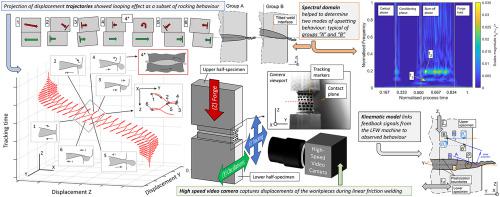International Journal of Machine Tools and Manufacture ( IF 14.0 ) Pub Date : 2020-12-11 , DOI: 10.1016/j.ijmachtools.2020.103674 D.S. Lachowicz , C. Bennett , D.A. Axinte , S. Lowth , A. Walpole , C. Hannon

|
Linear Friction Welding (LFW) has often been studied with the principal goal of describing complex physical interactions at the weld interface. Most published research has focused on the LFW process itself and under many assumptions: simplified welding geometries, over-constrained and rigid assemblies, and idealised clamping conditions. Equipment and tooling characteristics must be considered alongside the process itself for a more comprehensive understanding of LFW. The following study is aimed at addressing observed unaccounted variance in process outputs by investigating Ti6Al4V alloy welds processed under uniform conditions. A method for machine characterisation and a new experimental data analysis workflow is proposed, based on data processing techniques in spectral, temporal, and spatial domains. Research findings presented in this paper describe new plasticisation phenomena which accompany axial shortening in LFW welds. A new kinematic model is proposed, explaining macroscopic interactions at the contact interface. It allows for identification of shortening behaviour prevailing in the process, estimation of relative shape thickness of the thermo-mechanically affected zone, as well as potential for macroscopic misalignment between two joint substrates. Post-weld metrological investigations indicate a link between joint misalignment and effects observed, suggesting that tooling could influence weld shortening behaviour by disturbing planarity at the contact interface.
中文翻译:

钛合金线性摩擦焊接中工装行为对轴向缩短机理的影响及塑化效果建模
线性摩擦焊接(LFW)经常被研究,其主要目的是描述焊接界面处的复杂物理相互作用。大多数已发表的研究都集中在LFW工艺本身上,并基于许多假设:简化的焊接几何形状,过度约束的刚性组件以及理想的夹紧条件。为了更全面地了解LFW,必须与过程本身一起考虑设备和工装的特性。以下研究旨在通过研究在均匀条件下加工的Ti6Al4V合金焊缝来解决工艺输出中未观察到的差异。基于光谱,时间和空间领域的数据处理技术,提出了一种用于机器表征的方法和一种新的实验数据分析工作流程。本文介绍的研究结果描述了伴随LFW焊缝轴向缩短的新塑化现象。提出了一种新的运动学模型,该模型解释了接触界面处的宏观相互作用。它可以识别在该过程中普遍存在的缩短行为,估算热机械影响区域的相对形状厚度,以及两个连接基板之间宏观错位的可能性。焊接后的计量研究表明,接头错位与观察到的影响之间存在联系,这表明工具可能会通过干扰接触界面处的平面度来影响焊缝缩短行为。解释接触界面上的宏观相互作用。它可以识别在该过程中普遍存在的缩短行为,估算热机械影响区域的相对形状厚度,以及两个连接基板之间宏观错位的可能性。焊接后的计量研究表明,接头错位与观察到的影响之间存在联系,这表明工具可能会通过干扰接触界面处的平面度来影响焊缝缩短行为。解释接触界面上的宏观相互作用。它可以识别在该过程中普遍存在的缩短行为,估算热机械影响区域的相对形状厚度,以及两个连接基板之间宏观错位的可能性。焊接后的计量研究表明,接头错位与观察到的影响之间存在联系,这表明工具可能会通过干扰接触界面处的平面度来影响焊缝缩短行为。







































 京公网安备 11010802027423号
京公网安备 11010802027423号